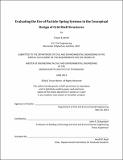Evaluating the use of particle-spring systems in the conceptual design of grid shell structures
Author(s)
Bertin, Trevor B. (Trevor Barnes)
DownloadFull printable version (4.444Mb)
Other Contributors
Massachusetts Institute of Technology. Department of Civil and Environmental Engineering.
Advisor
John A. Ochsendorf.
Terms of use
Metadata
Show full item recordAbstract
This thesis evaluates particle-spring systems as conceptual design tools in an effort to create efficient grid shell structures. Currently many simulation tools are available to create representations of intricate geometries and forms. However, these forms can become highly complex and challenging upon their realization. A lack of understanding of these forms leads to structures that cannot support their corresponding loads due to their shape, boundary conditions or edge conditions. To create successful grid shells, designers must understand the design principles behind these forms. The goals of this research were achieved through a parametric study that involved manipulating the topology and topography of three global grid shell geometries. It was determined that the ability of particle-spring form finding methods to create good structures is highly dependent on both the mesh type used and the structure's global geometry. A list of implications has been developed and is presented in this work.
Description
Thesis (M. Eng.)--Massachusetts Institute of Technology, Dept. of Civil and Environmental Engineering, 2013. This electronic version was submitted by the student author. The certified thesis is available in the Institute Archives and Special Collections. Cataloged from student-submitted PDF version of thesis. Includes bibliographical references (p. 63-64).
Date issued
2013Department
Massachusetts Institute of Technology. Department of Civil and Environmental EngineeringPublisher
Massachusetts Institute of Technology
Keywords
Civil and Environmental Engineering.